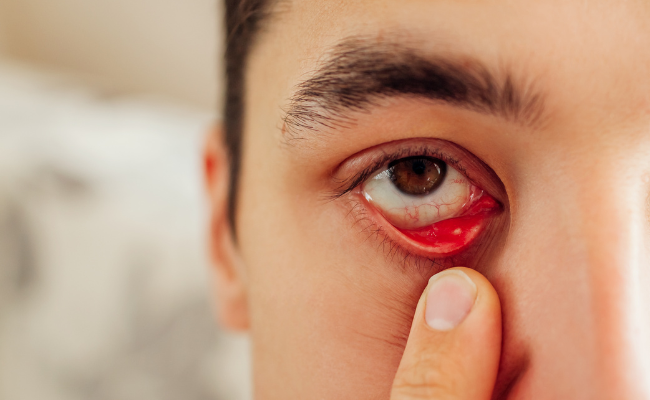How to Treat Ectropion?
- November 17, 2023
- No Comments

What is Ectropion?
Ectropion, a medical condition affecting the eyelids, involves the outward turning or sagging away from the eye, exposing the inner surface and leading to discomfort. Primarily associated with aging, it can affect one or both eyelids, with a higher prevalence in the lower lid.
Medically termed as an outward-facing eyelid, ectropion results in irritation on the inner surface and can occur in either the upper or lower eyelid, more commonly affecting the lower lid.Ectropion presents in congenital and acquired forms, with the congenital type being less common. Distinguishing between these types is essential for understanding the origins and progression of this eyelid condition.
Why Does Ectropion Occur?
The primary cause of ectropion is the aging process. As individuals get older, the skin loses its elasticity, and the muscles and tissues that support the eyelids may weaken. This natural aging-related tissue laxity can contribute to the outward turning of the eyelid margin. However, ectropion can also be caused by other factors such as facial nerve paralysis, sun damage resulting in changes to the skin, scarring from injuries or previous surgeries, and congenital factors.
How is Ectropion Diagnosed?
Diagnosing ectropion involves a comprehensive examination by an eye care professional. The doctor will typically start by taking a detailed medical history, including any relevant symptoms and potential contributing factors. A thorough physical examination of the eyelids and surrounding structures will be conducted to assess the extent of the ectropion. In some cases, specialized tests, such as Schirmer's test to measure tear production, may be performed to evaluate the impact on eye function. Additionally, imaging studies may be employed to further understand the severity of the condition.
Treatment Solutions for Ectropion:
- Artificial Tears and Lubricating Ointments: In mild cases of ectropion, over-the-counter artificial tears and lubricating ointments can provide temporary relief. These products help prevent dryness and irritation by maintaining adequate moisture on the surface of the eye.
- Eyelid Massage and Warm Compresses: Gentle massage of the eyelid, along with the application of warm compresses, can be beneficial for mild cases of ectropion. These non-invasive techniques aim to improve eyelid position and reduce symptoms, particularly in situations related to muscle weakness or mild tissue laxity.
- Taping or Temporary Sutures: To provide additional support and improve eyelid position, taping the eyelid or using temporary sutures may be recommended in certain cases. This approach is often considered a conservative measure when surgery is not immediately indicated.
- Prescription Medications: In instances where ectropion is associated with inflammation or infection, prescription medications such as topical antibiotics or anti-inflammatory ointments may be prescribed. These medications target underlying issues that contribute to the development of ectropion.
- Surgical Intervention: When ectropion is more severe or persistent, surgical correction may be necessary. The specific surgical procedure depends on the underlying cause and the extent of the condition. Common surgical approaches include tightening the eyelid muscles, removing excess tissue, or repairing supporting structures to restore a more natural eyelid position.
Benefits of Ectropion Treatment:
- Improved Eye Comfort: Treating ectropion helps alleviate uncomfortable symptoms such as dryness, redness, and irritation. By addressing these symptoms, individuals experience improved eye comfort and an overall better quality of life.
- Preservation of Eye Health: Managing ectropion is essential for maintaining optimal eye health. By addressing the condition promptly, potential complications such as corneal exposure and damage are minimized, reducing the risk of more serious eye problems.
- Enhanced Cosmetic Appearance: Surgical correction of ectropion not only addresses functional issues but can also have positive cosmetic effects. Restoring a natural eyelid position contributes to a more aesthetically pleasing look, which can be particularly significant for individuals concerned about their appearance.
- Prevention of Complications: Timely treatment can prevent complications associated with untreated ectropion. These complications may include recurrent infections, corneal ulcers, and other ocular issues. Proactive management is crucial for preserving long-term eye health and preventing more serious complications.
Comments (0)